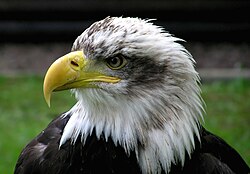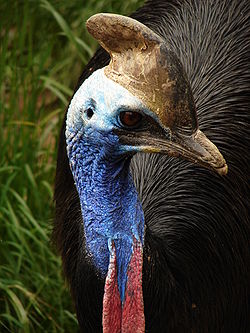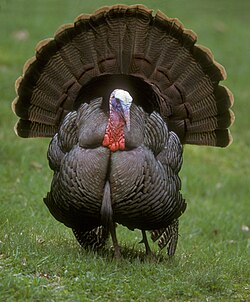List of bird genera Last updated November 02, 2025
List of bird genera concerns the Chordata class of Aves or birds , characterised by feathers , a beak with no teeth , the laying of hard-shelled eggs, and a high metabolic rate.
Restless flycatcher in the downstroke of flapping flight Portrait of a bald eagle , showing its strongly hooked beak and the cere covering the base of the beak. Eagles, Old World vultures, secretary-birds, hawks, harriers, etc.
Landing mallard drake Waterfowl
Nightjars, nighthawks, potoos, oilbirds, frogmouths and owlet-nightjars
The Madagascan nightjar is restricted to the islands of Madagascar and the Seychelles. Plovers, crab plovers, lapwings, seagulls, puffins, auks, sandpipers, buttonquails, stilts, avocets, ibisbills, woodcocks, skuas, etc.
European herring gull Rollers, bee eaters, todies, kingfishers, etc.
Like many forest-living kingfishers, the yellow-billed kingfisher often nests in arboreal termite nests. Sunbitterns and kagu
The sunbittern will open its wings to display two large eye spots when threatened Gamebirds
Despite its distinct appearance, the wild turkey is actually a very close relative of pheasants Cranes, crakes, rails, wood-rails, fluftais, gallinules, limpkin, trumpeters, and finfoots
Rails are one of the most widespread Gruiformes The cuckoo roller exhibits a pronounced sexual dichromatism in the plumage. Hoatzin at Lake Sandoval, Peru Bustards, floricans, etc.
Captive specimen of a male great bustard, showing the characteristic long, beard-like feathers and heavy build. Clockwise from top right: Palestine sunbird (Cinnyris osea ), blue jay (Cyanocitta cristata ), house sparrow (Passer domesticus ), great tit (Parus major ), hooded crow (Corvus cornix ), southern masked weaver (Ploceus velatus ) Passerines, the "song birds". This is the largest order of birds and contains more than half of all birds.
Family Acanthisittidae Family Acanthizidae – scrubwrens, thornbills, and gerygones Family Acrocephalidae – marsh- and tree-warblers, recently split from the Sylviidae Family Aegithalidae – long-tailed tits or bushtits Family Aegithinidae Family Alaudidae – larks Family Artamidae – woodswallows, butcherbirds, currawongs, and Australian magpie Family Atrichornithidae Family Bernieridae – Malagasy warblers, a newly assembled family Family Bombycillidae Family Buphagidae Genus Buphagus – oxpeckers – formerly usually included in Sturnidae Family Calcariidae – longspurs and snow buntings Family Callaeidae – New Zealand wattlebirds Family Calyptophilidae Family Campephagidae – cuckooshrikes and trillers Family Cardinalidae – cardinals and allies Family Certhiidae – treecreepers Family Salpornithidae – spotted creepers Family Cettiidae – ground-warblers and allies, recently split from the Sylviidae Family Chaetopidae Genus Chaetops – rockjumpers, recently split from the Turdidae Family Chloropseidae Family Cinclidae Family Cisticolidae – cisticolas and allies Family Climacteridae – Australian treecreeper Family Cnemophilidae – satinbirds Family Conopophagidae – gnateaters and gnatpittas Family Corcoracidae – Australian mudnester Family Corvidae – crows, ravens, and jays Family Cotingidae – cotingas and allies Family Dasyornithidae Genus Dasyornis – bristlebirds (formerly in Acanthizidae) Family Dicaeidae – flowerpeckers (sunbirds and flowerpeckers, might be included in Passeroidea) Family Dicruridae Family Donacobiidae Genus Donacobius – black-capped donacobius (previously classed as a wren, but probably closest to the Locustellidae or Bernieridae) Family Dulidae (tentatively placed here) Family Elachuridae Family Emberizidae Family Erythrocercidae Family Estrildidae – estrildid finches (waxbills, munias, and allies) Family Eulacestomidae Family Eupetidae Genus Eupetes – Malaysian rail-babbler (recently split from the Cinclosomatidae) Family Eurylaimidae – broadbills Family Formicariidae – antthrushes Family Fringillidae – true finches and Hawaiian honeycreepers (possibly polyphyletic) Family Furnariidae – ovenbirds and woodcreepers Family Grallariidae – antpittas Family Hirundinidae – swallows and martins Family Hyliidae – newly proposed for genera currently in other families Family Hyliotidae Genus Hyliota – hyliotas (recently split from the Sylviidae) Family Hypocoliidae Genus Hypocolius – grey hypocolius (tentatively placed here) Family Icteridae – grackles, New World blackbirds, and New World orioles Family Ifritidae Genus Ifrita – blue-capped ifrit Family Irenidae Genus Irena – fairy-bluebirds Family Laniidae – shrikes Family Leiothrichidae – laughingthrushes and allies Family Locustellidae – grass-warbler and allies, recently split from the Sylviidae Family Machaerirhynchidae Family Macrosphenidae – African warblers such as longbills and crombecs, a recently proposed family whose composition is still uncertain Family Malaconotidae – puffbacks, bushshrikes, tchagras, boubous, and allies Family Maluridae – fairywrens, emu-wren, and grasswrens Family Melampittidae Family Melanocharitidae – berrypeckers and longbills Family Melanopareiidae Family Meliphagidae – honeyeaters Family Menuridae Family Mimidae – mockingbirds and thrashers Family Mitrospingidae Family Modulatricidae – dapple-throat and allies (sometimes Arcanatoridae) Family Mohouidae Family Monarchidae – monarch flycatchers Family Motacillidae Family Muscicapidae – Old World flycatchers and chats. (Monophyly needs confirmation) Family Nectariniidae – sunbirds and spiderhunters Family Neosittidae Family Nesospingidae Family Nicatoridae Family Notiomystidae Family Oreoicidae – Australo-Papuan bellbirds Family Oriolidae – Old World orioles Family Orthonychidae Family Pachycephalidae Family Panuridae Genus Panurus – bearded reedling (formerly classed as a parrotbill) Family Paradisaeidae – birds-of-paradise Family Paramythiidae – painted berrypeckers Family Pardalotidae Family Paridae – tits, chickadees, and titmice Family Parulidae – New World warblers Family Passerellidae – New World sparrows Family Passeridae – Old World sparrows Family Pellorneidae – jungle babblers Family Petroicidae – Australasian robins Family Peucedramidae Family Phaenicophilidae Family Philepittidae – asities Family Phylloscopidae – leaf-warblers and allies (recently split from the Sylviidae) Family Picathartidae Family Pipridae – manakins Family Pittidae – pittas Family Pityriaseidae Genus Pityriasis – Bornean bristlehead (tentatively placed here) Family Platysteiridae – wattle-eyes and relatives (formerly in Passerida , probably paraphyletic) Family Ploceidae – weavers Family Pnoepygidae Family Polioptilidae – gnatcatchers Family Pomatostomidae – Australo-Papuan babblers Family Prionopidae – see Vangidae Family Promeropidae Family Prunellidae Family Psophodidae Family Ptiliogonatidae – silky flycatchers (tentatively placed here) Family Ptilonorhynchidae – bowerbirds Family Pycnonotidae – bulbuls Family Regulidae Family Remizidae – penduline tits (sometimes included in the Paridae) Family Rhagologidae Family Rhinocryptidae – tapaculos Family Rhipiduridae – fantails Family Rhodinocichlidae Family Salpornithidae Genus Salpornis – spotted creepers (tentatively placed here; often considered a subfamily of the Certhidae) Family Sapayoidae Genus Sapayoa – broad-billed sapayoa Family Scotocercidae Family Sittidae Family Spindalidae Family Stenostiridae Family Sturnidae – starlings Family Sylviidae – sylviid warblers and allies Genus Chamaea – wrentit Genus Chleuasicus – pale-billed parrotbill (formerly in Paradoxornithidae) Genus Cholornis (formerly in Paradoxornithidae) Genus Chrysomma (formerly in Timaliidae) Genus Conostoma – great parrotbill (formerly in Paradoxornithidae; tentatively placed here) Genus Fulvetta (formerly in Alcippe ) Genus Graueria – Grauer's warbler Genus Horizorhinus – Dohrn's thrush-babbler (formerly in Timaliidae) Genus Lioparus – golden-breasted fulvetta (formerly in Alcippe ) Genus Lioptilus – bush blackcap (formerly in Timaliidae) Genus Moupinia – rufous-tailed babbler (formerly in Chrysomma ) Genus Myzornis – fire-tailed myzornis Genus Neosuthora – short-tailed parrotbill (formerly in Paradoxornithidae) Genus Paradoxornis (formerly in Paradoxornithidae) Genus Parophasma – Abyssinian catbird Genus Pseudoalcippe (formerly in Illadopsis ) Genus Psittiparus (formerly in Paradoxornithidae) Genus Rhopophilus (formerly in Cisticolidae) Genus Sinosuthora (formerly in Paradoxornithidae) Genus Suthora (formerly in Paradoxornithidae) Genus Sylvia – typical warblers Family Teretistridae Family Thamnophilidae – antbirds Family Thraupidae – tanagers and allies Family Tichodromadidae Family Timaliidae – Old World babblers Family Tityridae – tityras and allies Family Troglodytidae – wrens Family Turdidae – thrushes and allies (Monophyly needs confirmation) Family Tyrannidae – tyrant flycatchers Family Urocynchramidae Family Vangidae – vangas, helmetshrikes, and allies Family Viduidae Family Vireonidae – vireos and allies Family Zeledoniidae Family Zosteropidae – white-eyes Family uncertain (This has traditionally been considered a member of the family Pachycephalidae, but recent genetic evidence suggests it should be placed in a monotypic subfamily of the family Bombycillidae, or even its own family, Hylocitreidae) A brown pelican ( Pelecanus occidentalis ) in Santa Barbara, California Pelicans, ibises, shoebills, egrets, herons, etc.
Red-billed tropicbird (Phaethon aethereus subsp. mesonauta ) in waters around Trinidad & Tobago Diving grebe Petrels, storm petrels, albatrosses, and diving petrels
The poorly known New Zealand storm petrel was considered extinct for 150 years before being rediscovered in 2003. Parrots, parakeets, macaws, and cockatoos
Most parrot species are tropical, but a few species, like this austral parakeet , range deeply into temperate zones. Pallas's sandgrouse in a field in the Gobi Desert A flock of rhea in Lenschow, Mecklenburg-Vorpommern. Adélie penguin (Pygoscelis adeliae ) feeding young. Like its relatives, a neatly bi-coloured species with a head marking. A male Somali ostrich in a Kenyan savanna, showing its blueish neck Boobies, gannets, frigatebirds, cormorants, shags, and darters
Little cormorant Phalacrocorax niger Great tinamou roosting This page is based on this
Wikipedia article Text is available under the
CC BY-SA 4.0 license; additional terms may apply.
Images, videos and audio are available under their respective licenses.









































